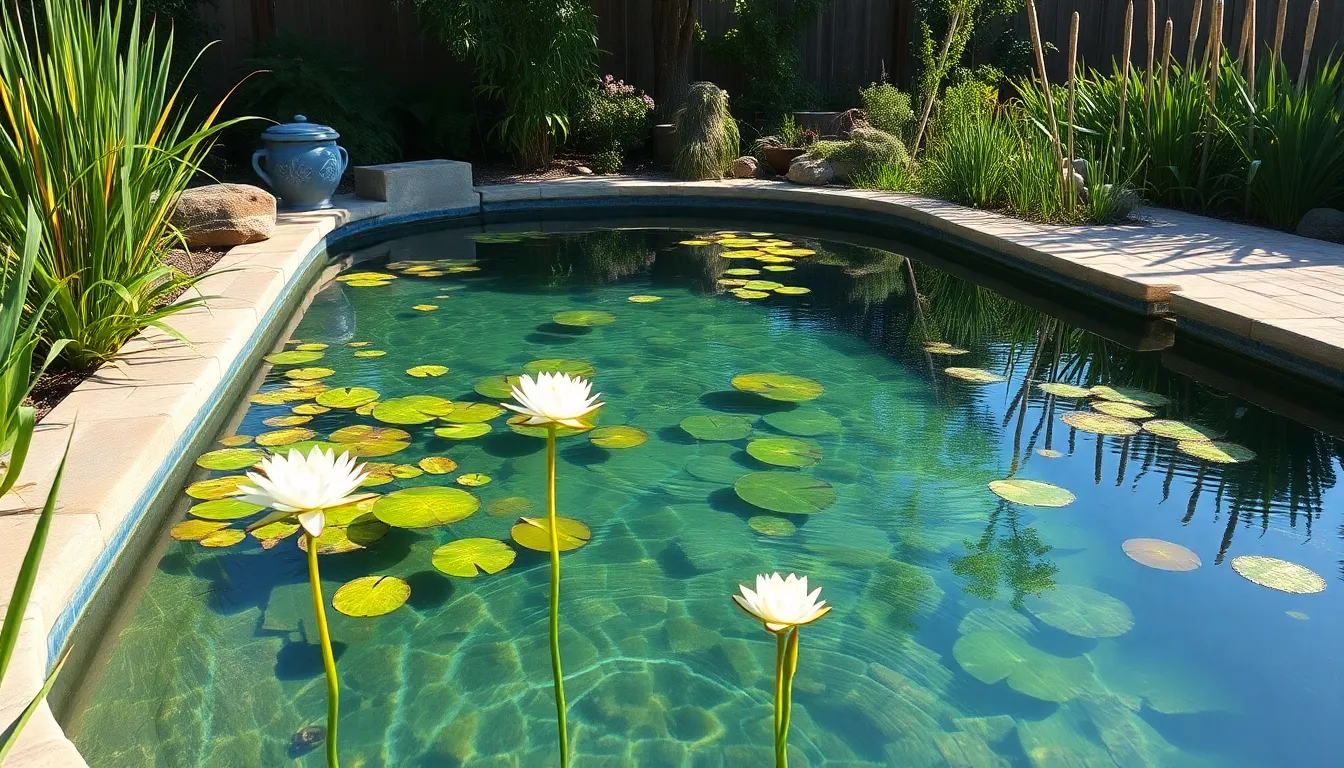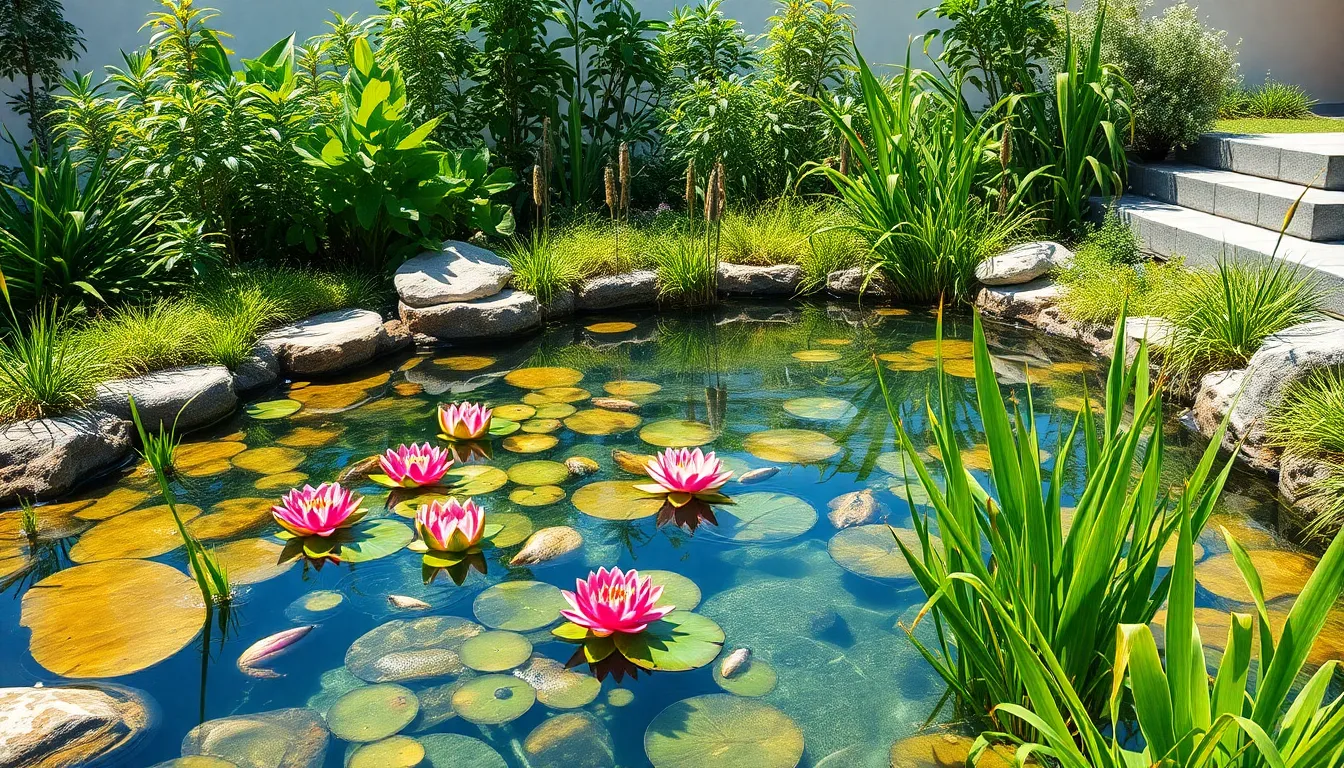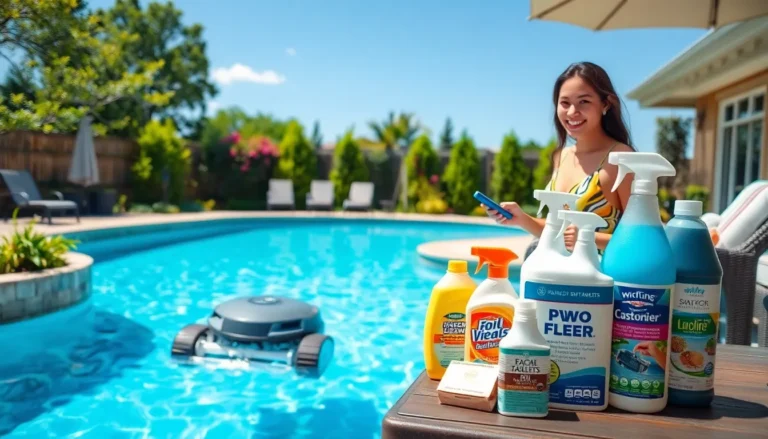Imagine diving into a crystal-clear oasis that cleans itself while you sip your favorite drink. Sounds like a dream, right? Welcome to the world of self-cleaning natural swimming pools, where nature does the heavy lifting and you get to enjoy the fun. With a little help from plants and beneficial bacteria, these pools create a serene environment that’s as refreshing as it is eco-friendly.
Table of Contents
ToggleOverview of Self Cleaning Natural Swimming Pools
Self-cleaning natural swimming pools blend aesthetics and functionality. These pools often feature a biological filtration system that relies on plants and microorganisms to purify water naturally. Beneficial bacteria play a crucial role in breaking down organic matter, ensuring clean and clear water, and creating a healthy swimming environment.
Design aspects include a designated regeneration zone filled with aquatic plants. This area facilitates the natural cleaning process, allowing plants to absorb nutrients and filter out debris. Maintaining balance in this ecosystem promotes water clarity and reduces the presence of algae.
Materials used in construction typically include natural stones and non-toxic liners. This choice not only enhances the visual appeal but also supports the environment. Each component works together to foster a self-sustaining habitat that minimizes the need for chemicals.
Pool size influences the regeneration area’s dimensions. A larger pool often requires a more substantial regeneration zone to support a diverse range of plants. Proper sizing ensures optimal filtration and enhances the overall experience for swimmers.
Maintenance routines are simpler compared to traditional pools. Regularly checking water levels and ensuring proper plant health suffices in keeping the ecosystem thriving. Occasional plant trimming and debris removal maintain the pool’s visual appeal and functionality.
Efficiency is another key aspect. Self-cleaning natural swimming pools typically consume less energy than conventional swimming pools. Utilizing sunlight and natural processes reduces reliance on mechanical filtration, leading to decreased operational costs.
Ultimately, self-cleaning natural swimming pools offer an eco-friendly swimming option that promotes sustainability and enjoyment without chemical interference or extensive upkeep.
Components of a Self Cleaning Natural Swimming Pool

Self-cleaning natural swimming pools incorporate various components that work harmoniously to maintain a clean and enjoyable swimming environment. These elements emphasize eco-friendliness and sustainability.
Biological Filtration System
A biological filtration system serves as the core of a self-cleaning natural swimming pool. This system utilizes beneficial bacteria to break down organic matter. Water passes through gravel and substrate layers, allowing bacteria to thrive and filter pollutants. Regular turnover of water ensures consistent cleansing, enhancing clarity. Many homeowners appreciate the reduced need for chemicals in this setup. Effective, this system significantly contributes to a healthy aquatic ecosystem, thriving without harsh additives.
Plant Life Integration
Integrating plant life into the design complements the biological filtration system. Aquatic plants absorb nutrients and assist in filtering debris from the water. Select plants also serve as natural habitats for beneficial microorganisms, promoting a balanced ecosystem. Water lilies and cattails are popular choices, as they enhance aesthetics and provide oxygen. These plants thrive in the regeneration zone, where they improve water quality and limit algae growth. Significant in maintaining natural clarity, the plant life creates an inviting environment for swimmers.
Design and Layout of the Diagram
Self-cleaning natural swimming pools feature a carefully planned design that enhances both functionality and aesthetics. The diagram helps visualize essential elements necessary for optimal performance and enjoyment.
Key Features Illustrated
The diagram highlights several key components. A regeneration zone filled with aquatic plants plays a crucial role in natural filtration, absorbing nutrients and debris. The biological filtration system clearly shows layers of gravel and substrate, where beneficial bacteria thrive, breaking down organic matter. Aquatic plants, such as water lilies and cattails, are depicted for their contributions to oxygenation and water clarity. Visual placement of these plants ensures that sunlight reaches them, promoting optimal growth. The pool’s shape and size influence the efficiency of these features, maximizing their effectiveness in maintaining clean water.
Best Practices for Arrangement
Arranging a self-cleaning natural swimming pool requires attention to detail. Designers should position the regeneration area adjacent to the swimming space for easy maintenance access. Placing larger plants toward the boundaries can prevent overcrowding, allowing for proper sunlight penetration. It’s essential to balance plant types to ensure diverse filtration processes. Utilizing natural stones for edges blends aesthetics with functionality, enabling a seamless integration with the surrounding environment. Regular maintenance practices should also be reflected in the design to facilitate ease of care and upkeep. Adjusting the pool’s layout according to specific site conditions can enhance efficiency.
Benefits of a Self Cleaning Natural Swimming Pool
Self-cleaning natural swimming pools provide numerous advantages over traditional pools. Reduced chemical use contributes to a healthier swimming environment, allowing swimmers to enjoy clearer water without exposure to harsh substances. Cost savings emerge from lower maintenance requirements, translating to less frequent chemical purchases and lower operational expenses.
Natural filtration enhances water quality. Beneficial bacteria work effectively to break down organic debris, which means cleaner water circulation. Increased biodiversity improves ecosystem stability, as aquatic plants contribute to nutrient absorption and enhance overall clarity.
Energy efficiency plays a crucial role. By relying on sunlight and natural processes for filtration, these pools consume significantly less energy than conventional systems. Reduced operational costs come along with lower power bills, making them financially appealing.
Aesthetic appeal is another notable benefit. Landscaping with aquatic plants not only beautifies the surroundings but also blends the pool into its natural environment. Diverse plant life creates habitats for wildlife, enhancing the ecosystem’s sustainability.
Simple maintenance procedures support ease of use. Regular checks on plant health require minimal effort, while occasional trimming keeps areas tidy. Users appreciate spending less time managing the pool and more time enjoying it.
Safety factors contribute to their appeal as well. Natural swimming pools minimize the risk of chemical exposure, providing a safer swimming environment, particularly for children and pets. The combination of eco-friendliness and safety presents a compelling reason to consider this option.
Flexibility in design allows customization to fit any landscape. Pool owners can adapt the regeneration zones to suit specific site conditions, optimizing both function and aesthetic integration. With these benefits, self-cleaning natural swimming pools present an attractive alternative for eco-conscious individuals seeking sustainability and enjoyment.
Self-cleaning natural swimming pools offer an innovative and sustainable alternative to traditional swimming options. By harnessing the power of nature through biological filtration and aquatic plants, they create a healthy and inviting swimming environment.
The integration of these elements not only enhances water quality but also promotes biodiversity and energy efficiency. With simple maintenance routines and customizable designs, these pools provide a refreshing escape that aligns with eco-conscious living.
Choosing a self-cleaning natural swimming pool means embracing a lifestyle that values both enjoyment and environmental responsibility.







